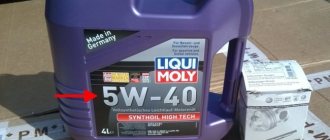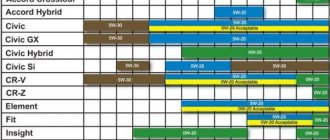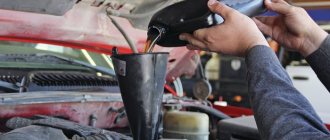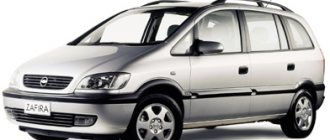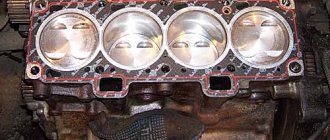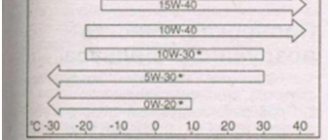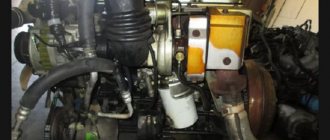Engine tuning options
Since the B20B engine is the only option without a variable timing system in the Honda B series, tuning in 90% of cases consists of installing VTEC from a B18 or B16 engine. There are some nuances:
The output is guaranteed to be a little more than 200 liters. With. To further increase the performance of the engine, mechanical tuning is used:
In this version, tuning will provide more than 240 hp. pp., but the engine modernization budget will increase sharply. Even with mechanical tuning, the B20B internal combustion engine is superior to engines of a similar class with a turbine or another type of supercharger.
Thus, the B20B engine has parameters of 180 - 180 Nm of torque, 125 - 150 hp. With. power and 8.8 - 9.6 units of mixture compression ratio. The manufacturer provides a capacity of up to 240 - 300 hp. With. for modification by the user's own efforts. The engine is considered one of the best, despite its discontinuation in 2002.
Source
Design Features
Initially, the B20B engine has the following design features:
- the cylinders are made of steel liners inside an aluminum block;
- “wet type” fit of liners improves heat dissipation, but reduces the spatial rigidity of the cylinder block;
- to improve performance, the cylinder head is equipped with 16 valves;
- two-shaft DOHC 16V type gas distribution mechanism, driven by a toothed belt;
- The pistons have a groove at the ends (counterbore) to prevent collision with the valves when the timing belt breaks.
Cylinder block B20B
Cylinder head B20B
Thanks to these nuances, major repairs can be carried out many times. To increase torque, it is possible to upgrade it yourself.
The best engine oil for Honda (Honda)
One of the most common power units that were installed in Honda cars at the turn of the millennium are two-shaft representatives of the “B” family, and the B20B engine is generally considered one of the most reliable in the history of the company. This is what was equipped with most models, which include such masterpieces of the Japanese automobile industry as the CR-V and StepWGN, as well as Orthia and S-MX.
In-line four-cylinder internal combustion engines of the “B” family were introduced to the world in 1988. Unlike D-engines, which primarily had one camshaft and were mainly intended for more economical use, gasoline B-engines were available in two versions - with both one and two camshafts.
In general, B20A, B20B, B20Z1 are quite ordinary DOHC units, without any special bells and whistles. They don't even have the famous VTEC system. The motors were modified many times, which was the reason for the appearance of several modifications.
*Engine numbers are located to the left of the exhaust manifold.
List of internal combustion engine modifications
During the entire production of the engine, the Honda manufacturer used different attachments and power drive markings:
- the geometry of the intake manifold and exhaust tract is different;
- Until 1999, engine power was limited to 128 hp. s., then this characteristic increased to 147 hp. With.;
- for the domestic market the marking B20B was used, for the external market B20Z1.
The main modifications of the B20B power drive are:
| In which Honda car was it installed? | Power (hp) | Compression ratio | Torque |
| StepWGN | 125 | 9,2 | 185 (4200 min-1) |
| CR-V (1997 – 1998) | 128 | 8,8/9,2 | 182 (5200 min-1) or 188 (4200 min-1) |
| CR-V (1996) | 130 | 9,6 | 190 (4200 min-1) |
| S-MX (1996) | 130 | 8,8 | 187 (4200 min-1) |
| S-MX (1999 – 2000) | 140 | 9,6 | 190 (4200 min-1) |
| Orthia (1995 – 1999) | 145 | 9,2 | 182 (5200 min-1) or 188 (4500 min-1) |
| CR-V (1999 – 2000) | 147 | 9,6 | 188 (4500 min-1) |
It is very difficult to visually distinguish engine modifications, since different intake manifolds are used, resonators appear and disappear in the exhaust tract, and one or two oxygen sensors are installed.
Description, composition and properties of the oil
Honda 0W20 oil is one of the latest high-tech developments of a world-famous Japanese concern that meets strict environmental standards.
Honda 0W20 engine oil is produced using catalytic hydrocracking technology from high-quality mineral raw materials.
A thoroughly cleaned base, enriched with additives based on molybdenum and calcium salts, which give the liquid resistance to wear and good cleaning properties, has unique characteristics.
Which car oil is better?
When purchasing engine oil for Honda, you need to take into account the existing wear of the engine. If it has not run 100,000 kilometers, you can continue to use the lubricant recommended in the service book:
- 5w30,
- 0w20.
When the internal combustion engine has run a lot longer, it is worth starting to fill in 5w40 oil. But it is only suitable for vehicles equipped with a timing belt. If the engine has a chain mechanism, the recommended oils will be most suitable.
Good to know! Some compounds are not suitable for Honda as they burn out badly. The list of “flammable” brands includes well-known brands - Shell, Castrol. And it's not a matter of poor quality. This is due to the high percentage of waste of Honda power units. The most suitable products are considered to be from well-known brands - Mobil, LiquiMoly.
Specifications
| Unit | Test methods | ||
| Viscosity | 0w-20 | SAE | |
| Appearance | transparent | visually | |
| Color | amber | visually | |
| Kinematic viscosity at 40°С | 36 | mm²/s | ASTM D445 |
| Kinematic viscosity at 100°С | 8.4 | mm²/s | ASTM D445 |
| Flash point in open crucible | 227 | °C | ASTM D92 |
| Pour point | -40 | °C | ASTM D97 |
| Density at 15°C | 868 | kg/m³ | ASTM D4052 |
| Base number | 9.2 | mg KOH/g | ASTM D2896 |
| Viscosity index | 225 | ASTM D2270 | |
| Total Acid Number (TAN) | 1.58 | mg KOH/g | ASTM D664 |
| Volatility according to PLA | 13.7 | % | ASTM D5800 (Method A) / DIN 51581-1 |
| Sulfate ash | 1.04 | % | ASTM D 874 |
Maintenance schedule B20B 2.0 l/126 – 150 l. With.
Initially, the B20B engine is unpretentious in operation, but maximum service life can be achieved by following the maintenance regulations:
- suspension and timing belts will need to be replaced after 90,000 km;
- It is recommended to visit a service station to adjust the thermal valve clearances every 30,000 miles;
- The manufacturer provides for cleaning the crankcase ventilation every 2 years;
- the developer recommends changing the oil and filter after 7500 km;
- the fuel filter must be replaced at least 40,000 miles;
- According to the manufacturer, the air filter must be changed annually;
- after adding antifreeze from the factory, the additives inside the coolant lose effectiveness after 40,000 km;
- spark plugs for engines in the DIS-2 system have a service life of 20,000 miles;
- The appearance of a burnout in the intake manifold is observed after 60,000 km.
After mechanical tuning, maintenance periods are completely preserved, and when installing a turbine, their frequency increases by at least 30%.
Oil for every Honda model
The Honda concern produces different car models, so each has its own types of recommended lubricants. Several options are discussed below.
Oil for Honda CR-V (Honda CR-V)
For Honda SRV you can use 2 groups of oils:
The first group can safely include 4 types of lubricants:
The following semi-synthetic materials can be safely filled into a Honda engine:
Oil for Honda Accord
This car model is extremely popular in Russia, but changing the oil still raises many questions among owners. Taking into account the age of the machine and engine wear, the following lubricants are recommended:
When using the listed products when changing oil in a Honda engine, it is not recommended to add third-party additives. The necessary substances are already added to the oil by the manufacturer.
Oil for Honda Civic
To understand which oil is safe to fill into a Honda Civic engine, you first need to decide on its type:
There are suitable options in both groups. If you plan to use synthetics, then you should choose the following brands:
Among semi-synthetics, the following are worthy of the attention of car enthusiasts:
List of car models in which it was installed
The B20B motor was designed for use in the following car models from the Honda manufacturer:
- C-RV – compact crossover;
- S-MX – compact van for the Japanese market;
- Orthia – front-wheel drive and all-wheel drive station wagon;
- StepWGN is a compact minivan.
Honda S-MX
The unique characteristics of the engine allow it to be used for swap (complete replacement) of cars of any other manufacturers.
Positive and negative aspects of the product
The presented product Honda 0W-20 has many positive characteristics, has special functions and capabilities, however, in order to use the product and make the car work as efficiently as possible, you should take into account the “strengths” of the lubricant:
The advantages are obvious, but the disadvantages are worth talking about separately. Many users write angry responses due to the fact that they are purchasing a fake. To avoid such a problem, you should be extremely careful when choosing a suitable product. Pay attention to the bottle or other container and carefully examine the label.
Additional assistance will be provided by a quality certificate, which the seller must have. The second drawback is its poor distribution in Russia and its considerable cost (from 640 rubles per liter). In some regions the product is extremely difficult to find. And lastly, the oil is not universal and is only suitable for winter. Additional details and lubrication are presented in the video:
Honda Ultimate Full Synthetic 5W30
Synthetics that were made in America, according to Honda's order. Properties and quality meet international requirements API, ILSAC. According to the manufacturer itself, the characteristics of such a lubricating composition far exceed those of similar motor fluids.
The oil is based on polyalphaolefins. The composition includes unique thickening additives. This made it possible to obtain a very high viscosity index. Its value reached 215 units.
In other words, this lubricant can work at any temperature, and it will not thicken or become very liquid.
Such properties allow the oil to be used in sports. The engine receives reliable protection from the heavy loads that the car has to endure.
Honda Ultimate Full Synthetic 5W30 can be used in the latest gasoline units in Honda vehicles. If the car is operated in Russia, the oil is replaced after 10 - 12 thousand kilometers.
Reliability and weaknesses of B20A, B20B, B20Z1
Motors of the B20 series do not have any special nuances and their reliability is clearly visible in the modes in which they operate. With “civilian” engines installed in the CR-V or StepWGN, everything is quite simple - problems in them appear after a mileage of 150 thousand km, and, as a rule, they are not serious at all.
Periodic maintenance comes down to timely replacement of technical fluids and consumables. If there are more reliable twin-shaft engines than the units of the entire “B” family from Honda, then they are unlikely to have been created yet.
The only really weak point of the “civilian” B20A/B/Z1 engines is the cylinder head gasket, which usually “breaks through” to 200 thousand km, but is this really the mileage for such a breakdown?! After all, sooner or later, even the most reliable motor must wear out something.
You can also note problems with the pump and thermostat and the fragility of the camshaft seals. Otherwise, the B20A/B/Z1, as already mentioned, are quite reliable engines, and in case of timely maintenance they operate without any complaints.
Review of faults and methods for repairing them
Besides the fact that the B20B motor does not bend the valve, its design does not have any defects. Possible malfunctions occur only after 150 thousand km:
| Oil leak | cylinder head gasket breakdown after 200 thousand kilometers | replacing the cylinder head gasket |
| Diesel knock | camshaft wear | replacing camshafts |
| Motor overheating | 1) thermostat wear 2) pump wear out | 1) replacing the thermostat 2) replacing the pump |
Repair B20B
The cost of the contract B20B is quite low, so the power drive is often replaced completely without major overhaul.
Tuning
It is the ability of B-engines for tuning that is highly valued and loved by Honda drivers all over the world. Even today, these engines are of great interest and a good basis for any modifications based on Honda power plants. With engines of this family, almost everything is possible, even the deepest boost of these units can be done ad infinitum, so let’s take a little look at the most popular “light” tuning recently, using the B20B as an example.
To assemble a B20B hybrid engine with VTEC, you will need a cylinder head with an intake and distributor from the B16A or B18C engines, which are most often found, as well as an ECU and, ideally, wiring. The final result after assembling such a hybrid is a two-liter power plant with a power of 200 hp or more. and with a bottom torque of 200 Nm. And all this without replacing the internal combustion engine block and, as a result, preserving the numbered unit. A car with a similar engine will have very few competitors even among modern HONDA models.
Also, an adequate installation of a turbo kit is possible on any of the B20A/B/Z1 engines. A sufficient power reserve allows you to experiment and increase the technical characteristics many times more.
Advantages and disadvantages
At the time of the creation of the B20B, the internal combustion engine device was considered the best in the world. No engine of a serial civilian car had such a power index of 100 hp/1000 cm3 of volume. Such powerful power drives were installed either on sports cars or motorcycles.
The main advantages of the B20B design are:
- high service life;
- multiple overhauls;
- easy-to-maintain layout of attachments;
- no collision of pistons/valves when the timing belt breaks;
- possibility of independent modernization (VTEC installation) to achieve 200 - 220 hp. With.;
- initially high characteristics.
Timing belt B20B without hydraulic pushers
The disadvantage is the lack of hydraulic compensators, due to which the user has to adjust the thermal clearances of the valves at intervals of 30–40 thousand km. According to drivers, the B20B engine has +5 points.
Reviews
Dmitry, 36 years old , 235 thousand, 0w20 constantly, does not consume oil, driving style is not a pensioner’s, I bought the car again from dealers.
Nikolai, 48 years old Honda 0w-20 is a normal oil, modern hydrocracking is not inferior to synthetics, in some places it is superior, study the analysis of the oil production.
Andrey, 57 years old If the manufacturer recommends Honda 0w20 for a 2-liter Accord, is it worth taking something else? The difference in price is not that great; personally, I take the original and am satisfied.
Marat, 39 years old I have been filling only this oil for 11 years. From replacement to replacement (about 10 thousand km), the level in the engine does not change!
B20A with a volume of 2.0 liters, with a power of up to 160 hp. (at 6300 rpm) and a maximum torque of 186 Nm (at 5000 rpm), installed on Accord, Prelude and Vigor.
The B20A four-cylinder in-line engine produced by Honda was produced in several versions from 1985 to 1990. Both carburetor and injection power systems were installed on the engine.
Engine Honda B20A
In its architecture, the B20A unit is significantly different from other Honda B-engines, and has practically no parts interchangeable with them.
| Engine capacity, cc | 1958 |
| Power, hp | 110-160 |
| Maximum torque, N m (kg m)/rpm | 152 (16)/4000 175 (18)/4500 177 (18)/4500 186 (19)/5000 |
| 175 (18)/4500 | |
| 177 (18)/4500 | |
| 186 (19)/5000 | |
| Fuel consumption, l/100 km | 5.1 |
| engine's type | in-line, 4-cylinder, DOHC |
| Cylinder diameter, mm | 81 |
| Maximum power, hp (kW)/rpm | 110 (81)/5800 140 (103)/6000 145 (107)/6000 160 (118)/6300 |
| 140 (103)/6000 | |
| 145 (107)/6000 | |
| 160 (118)/6300 | |
| Compression ratio | 9.4 |
| Piston stroke, mm | 95 |
| Models | Accord, Prelude, Vigor |
| Resource, thousand km | 300+ |
Honda Genuine Synthetic blend 5W30
Semi-synthetic oil manufactured according to VHVI technology. In other words, it is based on a mineral base. For purification, the catalytic hydrocracking technique is used.
This technology makes it possible to produce base oils whose quality is very similar to synthetics. It differs from synthetic products only in its lower thermal-oxidative stability.
That is why such a lubricating fluid requires frequent replacement. If the car is driven on Russian roads, a complete replacement is performed after 7 - 8 thousand kilometers. All other indicators correspond to those of 100% synthetics.
The lubricant is manufactured in the USA by Conoco Phillips. The European manufacturer remains unknown. According to some reports, the composition is manufactured in Germany. It is sold in a completely different container.
There are also analogues produced in Japan by the Idemitsu Corporation: Honda Ultra LTD Motor Oil SN 5W30, Ultra LEO and Gold.
BMW motor oil. Oil tolerances. What oil is better to fill?
Recommended brands of motor oil for BMW Group engines
| Engines/oils | Longlife-01 | Longlife-01FE | Longlife-98 | Specialist. oils | SAE 10W-60 | M610 | Specialist. ACEA |
| M43TU | |||||||
| M43/CNG | |||||||
| M47 | |||||||
| M47TU | |||||||
| M47TU after 03/2003 | |||||||
| M51 (E34/36) after 09/1995 | |||||||
| M52TU | |||||||
| M54 (**) | |||||||
| M57 | |||||||
| M57TU | |||||||
| M57TU after 03/2003 | |||||||
| M62LEV | |||||||
| M67 | |||||||
| M67 (E65) | |||||||
| M73 (E31) after 09/1997 | |||||||
| M73 (E38) 09/1997 - 08/1998 | |||||||
| M73LEV | |||||||
| N40 | |||||||
| N42 | |||||||
| N45 | |||||||
| N46 | |||||||
| N52 | |||||||
| N62 | |||||||
| N73 | |||||||
| S54 | |||||||
| S62 (E39) up to 02/2000 | |||||||
| S62 (E52) | |||||||
| W10 | |||||||
| W11 | |||||||
| W17 | |||||||
| Other engines/models (*) |
* “Other engines/models” include all BMW engines/models that are not included in the table. (these include: M10, M20, M21, M30, M40, M41, M42, M43, M44, M50, M51, M52, M60, M62, M70, M73, S14, S38, S50, S50U, S52, S70 and others ).
** For cars with M54, production before 08/2001, Longlife-98 oil is also recommended for use.
According to BMW specifications, for models 1, 3, 4, 5, 6 and 7 series with gasoline engines, only motor oils that have passed special tests and are officially approved by BMW are allowed for use. For cars of the same series with diesel engines, the use of universal oils is permitted that meet the requirements of certain types according to the ACEA classification (in accordance with the vehicle documentation).
If the oil has successfully passed all the necessary tests and is approved by BMW, then the corresponding approval must be indicated on the packaging of this oil, as can be seen in the photograph. If there is no such indication, this means that the oil is not certified by BMW.
BMW Group engine oil recommendations vary depending on the model and engine/vehicle type. The company divides oils into groups based on the results of numerous control tests and checks of the condition of the oil.
Certified BMW Group oils:
1). Longlife oils.
Such oils comply with ACEA:A3/B3 specification standards. These oils are also tested by BMW tests for extended maintenance intervals. OilService service, and they are suitable for use in any season, regardless of the ambient temperature. As control conditions became more stringent since 2001 and a new generation of engines appeared, oil with a long service life was divided into several categories:
2). Special Oils
This category of oils also meets ACEA:A3/B3 requirements and is the predecessor of BMW Longlife oils. Can be used on older models with maintenance intervals. liquids up to 15 thousand km. according to OilService regulations. Special Oils can be used all year round, and SAE 10W-X oil at an ambient temperature of at least 20 degrees. WITH.
What to pay attention to
For BMW Group engines, only motor oils that meet the above recommendations should be used. Names such as "low-friction motor oil" or "full synthetic", etc. do not provide any useful information about the quality and suitability of use in BMW car engines. Let's take a closer look at several types of such oils:
These instructions are of secondary importance when choosing oil. The decisive criterion in determining the quality of the oil is the indication of the BMW license.
"Family Doctor" for your Honda
When it comes to choosing oil, tires... as well as music or drinks, I adhere to the rule: “there are no comrades according to taste and color.” Giving advice in such cases is a thankless task, but since I am regularly asked such questions in the “Consultation” or by e-mail, so as not to repeat myself every time, I decided to write all my thoughts in one place.
Question one: what brand, does it have to be Honda?
I believe that Honda motor oil is no better or worse than any modern oil from other well-known brands. This is primarily due to the fact that all motor oils for cars are now subject to uniform standards: in the USA these are API, in Europe ACEA, and there is also an international type (established by the joint American-Japanese association) ILSAC.
Let’s take a look at several Honda brand oils that are common in Russia and read the “labels”.
Here is the “ULTRA” series in iron cans (the so-called “Japanese”):
It is highlighted that the oil meets the SH specifications according to the API standard, and GF-5 according to the ILSAC standard. This means that the oils meet the latest and most stringent requirements for gasoline engine oils. Moreover, only on the “Ultra Gold” can it is written that it is 100% synthetic; on the others, nothing specific is written about this either on the front, back or side. It’s easy to find “investigations” on the Internet claiming that oils are made by hydrocracking. And by the way, among them there are revelations about the origin of these oils from Idemitsu, for example here: https://www.drive2.ru/b/474166039819584244/. The “iron” series is produced by the Japanese corporation JX Nippon Oil & Energy, owner of the ENEOS brand.
But another line, the so-called. "European", its representatives HFS-E and Type 2.0:
This is generally a murky matter, the labels on different cans differ - on HFS-E it is confidently stated that it is “full synthetics”, on “Type 2.0” it is written about some kind of “synthetic technology”. With the latter there is a general “misunderstanding” - in the viscosity designation, instead of zero, the letter “O” is quite definitely printed, and on both sides... this cannot be called a typo. Only on HFS-E was it possible to find a mention of compliance with any standards, and even then the information was not the same for all and not everywhere. Some of the bottles indicate compliance with the American standard API SN, and I came across this one:
It is stated here that the same brand “HFS-E” corresponds to the previous ones, i.e. a slightly outdated class according to the API standard: SL/CF, and also not the newest specifications according to the European ACEA standard: A5/B5. Apparently the bottle was lying around from the previous decade.
But in some places there was a mention of the manufacturer. And this is oddly enough Idemitsu:
Well, now the “American” series:
American bottle labels are much more informative. Some of them are full synthetics, some are a “blend” (apparently semi-synthetic). But compliance with API SN and ILSAC GF-5 standards is clearly stated. It was not possible to definitely find out who produces them. There are many mentions on the Internet that Exxon-Mobil makes oil for Honda in the American market. Most likely this is true, but I haven’t seen any documentary evidence, and I haven’t really looked for it.
On this, I think, the review of original oils can be completed. All of them are modern high-quality motor oils produced by the “giants” of the oil refining industry. Their belonging to the API SN class means that they are intended for gasoline engines, including those produced after 2010, must ensure stable performance throughout the entire service life, have an extended service life, efficiency, environmental friendliness and even protection of rubber engine components...
Now let's take a quick look at a few popular alternatives.
First of all Idemitsu:
By the way, the picture was taken from here: https://www.drive2.ru/b/494829436718285002/ - a very interesting note about the differences between Idemitsu of Japanese and Singapore origin, I advise fans of the brand to read: laboratory tests showed complete identity. But I want to draw attention to compliance with standards - API SH, ILSAC GF-5. Will it fit? Quite!
The next global brand is “Mobil1”:
Here they claim compliance with the SN class according to the API and the previous SM class (although it seems that the latter class automatically implies compliance with the previous classes). And also C2 C3 according to ACEA - these are universal classes for gasoline and diesel engines, not the latest, but quite modern. There is no approval from the “international” Japan-American Association (apparently this series of oils is intended for the European market). But from the compliance with the SN class, it turns out that it is quite suitable for Hondas, including new ones.
I couldn’t pass by the MOTUL brand, since the fans of this oil on the Internet, it seemed to me, are among the most active. The assortment is huge, so I took it at random from the fairly common “8100” line with a viscosity of 5W30:
We look at the label: ACEA A5/B5, API SL/CF. Not the latest API class is SL (it was replaced in 2004 by the SM class, and SN came in 2010). According to ACEA, the requirements are also not the latest; for cars that meet the Euro-4 environmental regulations, classes C have been introduced. For use in Honda engines, the latest generation is no longer suitable, but it is quite suitable for its predecessors, especially if you remember Honda HFS-E oil from the “previous decade” (see above).
And finally: the choice of CR-V club service and my personal preference is Petronas.
The cheaper line is Syntium 3000, and the more expensive line is Syntium 7000E. API class SN, ACEA C3 and C2, and the latter has ILSAC GF-5. The whole set of the latest requirements, no worse than the original Honda oil. I would like to take this opportunity to explain my choice of this particular oil. The brand is little known in our country and is not very widespread; not every auto store can find it. But this is the beauty - such a brand is less interesting to manufacturers of counterfeits. In fact, Petronas is a world-class Malaysian state-owned company, widely represented not only in Asia, but also in the European market, and is a sponsor of the Mercedes Formula 1 racing team. This is the first one. And second: Petronas Syntium are truly high-quality motor oils. And if it is written that it is synthetic, then it really is synthetic, confirmed by research on oil-club.ru. Moreover, it uses its own raw materials, here is a quote from Wikipedia: PETRONAS was the first in the world to produce base oils based on liquefied natural gas. and also successfully processes associated gas that was previously flared. Due to this, it has the purest base oil products, some of the best in quality.
So what should you choose? Here I will return to where I started, “taste and color, no comrades.” Look at the labels, compare the specifications... The choice is huge and, unfortunately, very filled with fakes. Therefore, my advice here is this: choose not a brand, but a seller - it’s better to choose an oil that is not fake.
Question two: what viscosity oil is better?
Let's start with the theory. For some reason, many car owners believe that in the oil viscosity labeling, the first number is tied to the winter temperature, and the second to the summer temperature. This is only half the truth, as for the first number - it characterizes the viscosity of the oil in a cold state. The larger it is, the thicker the oil is when cold. This means there is a problem with pumping oil during a cold start of the engine. Experts recommend a simple way to determine this parameter:
To find out this temperature, you need to subtract forty from the first digit - for example, for 10W-40 we get a value of minus 30...
Those. oils with a viscosity of 5W-xx are quite suitable for Moscow and the region where frosts greater than minus 35 are rare. But for more severe climatic regions, it is better to take oils starting from scratch - 0W-xx.
The second digit (after the hyphen) has no connection with climatic operating conditions! It characterizes the viscosity of the oil at a temperature of 100 degrees. Since all modern (and not very modern) internal combustion engines have an operating temperature of about 100 degrees, it doesn’t matter what the outside temperature is, whether it’s summer or winter. Those. the second number characterizes the operating viscosity of the oil. And it affects the thickness of the oil film this oil can create. The higher the viscosity of the oil, the greater the thickness of the oil film formed by the oil in friction pairs, and the thicker the film, the better it protects the rubbing parts from wear, and also better seals the piston group parts, increasing engine power. It turns out that the higher the oil viscosity, the better for the engine, both for durability and power. For this reason, high-viscosity oils with indexes such as 5W-50, 10W-60 and even 25W-70 are poured into sports car engines. But there is a nuance here: too high an oil viscosity also reduces engine power due to losses in mechanically overcoming this very viscosity, and the smaller the gaps between parts, the greater these losses. Because of this, cars are usually limited to a viscosity of 40 or 30, and in the pursuit of efficiency, a tendency has arisen to reduce the viscosity to 20. True, the price for this saving is the life of the engine and this should not be forgotten. You should also take into account the age of the engine - the older, the better the thicker oil.
Thus, we choose a compromise: 5W-30 or 5W-40 for regions with a relatively warm climate, and for frosts it is better to use 0W-30 or 0W-40.
Separately, we need to focus on liquid oils - 0W-20, 5W-20. There is a persistent opinion among Honda car owners that low-viscosity oils are preferable for their engines, and this opinion is supported by the manufacturer’s recommendation. Here and there on the Internet there are stories about “narrow oil channels” in Honda engines. Is it really the manufacturer, i.e. Does Honda Corporation recommend 0W20 or 5W20 oil for its engines? Let's find out...
Argument No. 1: oil filler cap.
On Hondas that came to us from America, there is a very informative oil filler cap: there is a reminder that this is a hole for engine oil, and that the oil should be for gasoline engines, and the viscosity is indicated - 5W20, and there is also a recommendation to look at the instruction manual. Well, there’s nothing to argue with here, but let’s look at the manual anyway...
Argument No. 2: instruction manual.
Here is a screenshot from the owner's manual for the 3rd generation Honda CR-V (2007-2011):
By the way, here are the tolerances for API oil classes not lower than SL (let me remind you that SM and SN are newer classes) and fairly wide ACEA tolerances: A1/B1, A3/B3, A5/B5. This is related to the previous question about the applicability of different brands of oils. But now we are interested in viscosity recommendations, and they are as follows: in the entire climatic range, the use of 0W-20, 0W-30, 0W-40, 5W-20, 5W-40 is allowed, but 10W-30 and 10W-40 oils can be used only in relatively warm climates (temperatures no less than minus 20...). There is no recommendation or preference for 0W20 oil here! Moreover, this oil can only be used on cars supplied to Europe, but not for other countries...
To be fair, let's look at the manuals for other models of the brand. Here is a screenshot from the manual for the 7th generation Accord (2002-2007):
Here the developers are not afraid of oil even with a viscosity of 15W40 (of course not for the Russian climate), but otherwise the recommendations are still the same.
Of course, the models are not entirely new, but it was on these machines that in those years the “K” series engines were installed, which so frightened some motorists with their “narrow” oil channels.” And disputes about 0W-20 arose even then.
But let's look at the newer models - the 9th generation Civic (released since 2012):
0W20 oil is not mentioned here at all! Take my word for it: in the manual from which I took this screenshot, there was no division between cars for Europe and others. There is only one, this recommendation, and judging by the fact that the instructions are written in Russian, this instruction is not for Africa... Moreover, here the manufacturer definitely allows the use of not only original oils in the engine.
For Pilot or Legend engines, oil with a viscosity of 30 and higher is also recommended, not a word about any 0W-20. For those interested, you can download the operating manuals on the official website: https://www.honda.co.ru/cars/service/documents/.
I found a recommendation for using oil with a viscosity of 0W-20 in the instructions for the 4th generation CR-V (production from 1012):
It is curious that the recommendation “0W-20 and only 0W-20” is again relevant for Europe. For other countries it is not recommended at all - 0W30 and above!
It turns out that 0W-20 and 5W-20 are recommended only for models with “K” series engines. Here again the “myth of narrow channels” of these engines comes to mind. But even if this is so, how can we explain that liquid oil is recommended for some regions, but not for others? The motors are the same! Why are there different recommendations for different models, but with the same engines? For example, the Series and “K” engines were installed on both the Accord and the CR-V, and the “R” series engines were installed simultaneously on the CR-V and Civic. But at the same time, for Accord and Civic with these engines, 0W-20 oil was recommended either among others or not recommended at all, but for the CR-V there is an unambiguous recommendation for this viscosity.
Separately, I would like to note that over many years of practice in servicing Hondas, including adjusting valve clearances, replacing timing chains and camshafts, I have not been able to identify any pattern between the frequency of cases of camshaft cam wear or chain stretching and the viscosity of the oil used. It cannot be said that with 0W20 oil the shafts “cover” more often, and vice versa, that such cases happened more often to those who drive 5W40.
Thus, we can safely say that the recommendation to fill a Honda engine with low-viscosity oils is dictated solely by marketing. Firstly, such oils are cheaper to produce (it is always more difficult and expensive to produce oil with a wider range of stable characteristics). And secondly, this recommendation is given only for European countries, obsessed with economy and ecology. But the price to pay for saving is the resource of the engine itself. But since the global automobile industry has set a course toward reducing the service life of vehicles, manufacturers are not at all concerned about this.
If you still use 0W-20, 5W-20 oils, then I recommend switching to shortened intervals between oil changes, as for severe operating conditions, i.e. change the oil after 7 - 7.5 thousand kilometers. This way you will cause less damage to the engine, since liquid oils lose their properties faster and cannot withstand long-term use.
ps I fill myself with Pertonas Syntium 7000 0W-40 API SN ILSAC GF-5...
B20B
| Production | Honda Motor Company |
| Engine make | B20B |
| Years of manufacture | 1995-2002 |
| Cylinder block material | aluminum |
| Supply system | injector |
| Type | in-line |
| Number of cylinders | 4 |
| Valves per cylinder | 4 |
| Piston stroke, mm | 89 |
| Cylinder diameter, mm | 84 |
| Compression ratio | 8.8-9.6 |
| Engine capacity, cc | 1972 |
| Engine power, hp/rpm | 126-150/5400-6300 |
| Torque, Nm/rpm | 180-184/4800-4500 |
| Fuel | 92/95 |
| Environmental standards | up to Euro 2 |
| Engine weight, kg | ~145 |
| Fuel consumption, l/100 km - city - highway - mixed. | 11.9 8.4 10.0 |
| Oil consumption, g/1000 km | up to 1000 |
| Engine oil | 5W-30 5W-40 10W-30 10W-40 |
| How much oil is in the engine | 3.8 |
| When replacing, pour, l | 3.5 |
| Oil change carried out, km | 10000 (better 5000) |
| Engine operating temperature, degrees. | 90 |
| Engine life, thousand km - according to the plant - in practice | — 300+ |
| Tuning - potential - without loss of resource | 400+ n.a. |
| The engine was installed | Honda C-RV Honda Orthia Honda S-MX Honda StepWGN |
The B20B engine is the popular and most powerful representative of the Honda B series (B16, B17, B18), which is based on an aluminum cylinder block with steel liners.
The height of the B20 cylinder block is 212 mm, the crankshaft has a piston stroke of 89 mm, the length of the connecting rods is 137 mm, and the height of the pistons is 30 mm. The motor head is a two-shaft 16-valve, the timing belt drive is, the belt must be replaced every 100,000 km; if the timing belt breaks, the valve motor often does not bend rather than bend. The engine is not equipped with hydraulic compensators; valve clearances on the B20B are adjusted once every 40,000 km. The engine is extremely simple, there is no VTEC variable valve timing system, but with simple manipulations this issue can be resolved, more on this later. The B20B engines had some variations, the very first came in a 128-horsepower version, after 1998 the power increased to 147 hp, the Japanese ones were more powerful - 145 hp, from 1998 - 150 hp. Series B engines are rightfully considered one of the most reliable and unpretentious Honda engines; the engine does not have any obvious weak points: camshaft seals do not last long, on serious runs the cylinder head gasket can break, the pump or thermostat periodically dies, after which we get overheating . In general, the engine is very good, with proper maintenance it lasts a long time, the b20b service life is about 300 thousand km or more. If the engine has arrived and requires overhaul, then it is easier and cheaper to buy a contract B20B engine, the price is not bad.
The V20V engine was produced until 2001, then it was replaced by the more modern K20A.
Atmospheric. B20B VTEC
The most common, rational and, indeed, fast-moving type of tuning for the B20B is the installation of a VTEC cylinder head from the B16. Such transformations will significantly increase engine efficiency and power, without serious damage to service life, reliability, etc.
To do this, you need a B16 or B18 head assembly, ARP studs, Hondata for tuning and various small things, the output will be more than 200 hp.
To push the engine to the end, we change the pistons to WISECO (or others) with a compression ratio of 12 (or more), we do porting of the head, Skunk2 Stage 2 camshafts, lightweight valves, a cold intake with a large flap, a Skunk2 (or other) receiver, performance injectors 300-360 cc, Walbro fuel pump 255 lph, 4-2-1 exhaust on a 63 pipe. As a result, we get about 240 atmospheric forces, less on standard shafts, more on even more evil ones, but you shouldn’t twist too much either. Tuning the B16A/B16B cylinder head is described in this article.
B20B turbo
For even more hellish Valilov, you can turbo the above configuration, having first replaced the pistons with others, at a low degree (about 8.
5), Carrillo connecting rods, simpler shafts (standard or stage 1), 550 cc injectors (or more), on ebay we select the turbo kit we like with an intercooler and everything related, install it, tune it and inflate it for 300 hp.
This should definitely be enough, but you need to remember that when increasing power, you should take care of the other components of the car, so the financial costs of building powerful writhing will not be childish.
ENGINE RATING: 4++
The B20B engine is installed on cars:
Honda CR-V
Japan
Honda CR-V (12.1998 - 08.2001)
restyling, jeep/suv 5 doors, 1st generation, RD
Honda CR-V (10.1995 - 11.1998)
jeep/suv 5 doors, 1st generation, RD
Europe
Honda Orthia
Honda Orthia (06.1999 - 01.2002)
2nd restyling, station wagon, 1st generation
Honda Orthia (02.1997 - 05.1999)
restyling, station wagon, 1st generation
Honda Orthia (02.1996 - 01.1997)
station wagon, 1st generation
Honda S-MX
Honda S-MX (09.1999 - 03.2002)
restyling, hatchback 5 doors, 1st generation, RH1
Honda S-MX (11.1996 - 08.1999)
hatchback 5 doors, 1st generation, RH1
Honda Stepwgn
Honda Stepwgn (05.1999 - 03.2001)
restyling, minivan, 1st generation
Honda Stepwgn (05.1996 - 04.1999)
minivan, 1st generation
Reliability, problems and repair of the BMW B48 engine
A new version of the four-cylinder petrol engine from Munich, designated B48, was shown in 2014 and replaced the popular N20. The B48 engine was developed on the basis of the N20, but differs from it quite significantly: the 48th has its own closed aluminum cylinder block, where a long-stroke crankshaft with a piston stroke of 94.6 mm is installed on five supports. The cylinder diameter is now 82 mm, the walls have a wear-resistant coating 0.3 mm thick, and the inter-cylinder distance is 91 mm. This geometry makes it possible to obtain 500 cm3 per cylinder and a total volume of 2 liters. There are also 2 balancer shafts used here, but they differ from the N20.
The block is covered with an aluminum 16-valve head with two camshafts and direct fuel injection. The diameter of the intake valves is 30 mm, the exhaust valves are 28.5 mm, the thickness of the intake valve stems is 5 mm, and the exhaust valves are 6 mm. The intake camshaft is equipped with a Valvetronic variable valve lift system (from 0.2 mm to 9.9 mm) and a Double VANOS variable valve timing system is present on both shafts. The camshafts are driven by a chain drive, where a single-row timing chain is used. The MHI TD04LR6W twin-scroll turbocharger is installed here, which creates 0.5 bar of excess at 20i. The liquid-cooled intercooler is integrated into the intake manifold. The new internal combustion engine is controlled by its Bosch MG1 unit.
In the North American market, this motor is sold under the designation B46 and is compliant with ULEV II environmental standards. A version for hybrid cars with the index 30e is also available, which is a 184-horsepower gasoline engine and an 88-hp electric motor. In total, this power plant produces 252 hp.
This engine has related engines: 6-cylinder B58 and 3-cylinder B38.
BMW B48 engine modifications
1. B48B20M0 / B20B20A (2015 - present) - the most derated version with a power of 184 hp. at 5000-6500 rpm, torque 290 Nm at 1350-4250 rpm. The motor is designed for longitudinal installation, the compression ratio here is 11, the boost pressure is 0.5 bar. There is such a motor on BMW with the index 20i.2. B48A20M0 / B20A20A (2014 - present) - analogous to B48B20, but installed transversely. This modification is found on the BMW X1 and X2 with the designation 20i, on the BMW 220i Active Tourer, as well as on the MINI Cooper S of various versions. Power 192 hp at 5000-6000 rpm, torque 280 Nm at 1350-4600 rpm.3. B48A20M1 (2018 - present) - version for BMW X2 with the designation 20i. Power 192 hp at 5000-6000 rpm, torque 280 Nm at 1350-4600 rpm.4. B48B20O0 / B48B20B (2016 - present) - longitudinal version for the BMW 125i F20, where the pressure is increased to 0.9 bar, the compression ratio is reduced to 10.2, the exhaust diameter is 75 mm. Engine power reaches 224 hp. at 5200-6500 rpm, torque 310 Nm at 1400-5000 rpm. 5. B48A20O0 / B48A20B (2014 - present) - transverse version for Mini John Cooper Works, BMW X1 xDrive 25i and 225i Active Tourer. Power is 231 hp. at 5000-6000 rpm, and torque 350 Nm at 1450-4500 rpm. 6. B48B20O0 (2015 - present) - version where the boost pressure is increased to 1 bar. Power - 252 hp. at 5200-6500 rpm, torque 350 Nm at 1450-4800 rpm. There is such an internal combustion engine on a BMW with the designation 30i.7. B48B20O0 (2013 - present) - top modification with a power of 258 hp. at 5000-6500 rpm, torque 400 Nm at 1550-4400 rpm. A similar power plant is installed in the BMW 630i and 730i. 8. B48B20O1 (2018 - present) - modification for the BMW Z4 sDrive 20i, which has 197 hp. at 4500-6500 rpm, torque 320 Nm at 1450-4200 rpm.
Problems and disadvantages of BMW B48 engines
These motors have not been produced for so long and no special problems or miscalculations have yet been noticed with them. These are reliable engines that drive quite well and do not fall apart early. The main thing is to pour good 98-grade gasoline, non-counterfeit, high-quality oil and change it 2 times more often than required, then everything will run for a long time. Among the known problems, it is worth noting vibration, which is inherent in all B48s. Also, closer to 100 thousand km, the damper in the muffler may begin to make noise, which does not threaten anything, but if you want to eliminate this noise, then you need to change the entire muffler. The approximate service life of this motor is not yet known.
